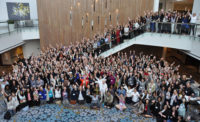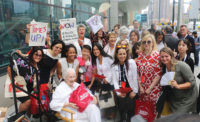Almost 400 architects gathered this past weekend for the AIA Women’s Leadership Summit (AIAWLS)—a gathering with a focus on “creating tailwinds” to advance women’s pathways to leadership. This year’s sold-out conference in Washington, D.C., is the fifth iteration of the AIAWLS, which started as an effort by the Women’s Principals Group of the Boston Society of Architects to share and learn from examples of female success in the profession.
Through sessions that explored topics such as the business case for inclusive workforces (in short, the more diverse a firm is, the more profitable and successful it will be), the conference brought together women in leadership roles to share their experiences with their peers. Studio visits to D.C.-based firms and to the local offices of multi-national firms highlighted inclusiveness in real-world settings, and a keynote address from Susan L. Colantuono, CEO of Leading Women, galvanized attendees to recognize their own leadership qualities as a means of generating internal momentum.
An intensive day of leadership programming kicked off with a welcome address by Rosa Sheng—the founding chair of Equity by Design, president-elect of AIA San Francisco’s board of directors, and a senior associate with Bohlin Cywinski Jackson. Sheng emphasized importance of transparent discussion, citing the AIA’s adoption of Resolution 15-1, which formalizes principles of equitable practice. She also teased findings of the 2016 Equity in Architecture Survey, which will be released publicly before the end of the year. According to Sheng, survey results indicate that architects often compromise personal welfare for professional aspirations, and that there’s enormous disparity in salary by caregiver status.
2016 Equity in Architecture Key Findings Presentation - AIASF Equity by Design from Rosa T. Sheng on Vimeo.
After her formal talk, Sheng went on to discuss the conference’s goal of creating a pipeline to build the next generation of leaders by framing other women’s success stories as training: “This particular conference has been focused on skill building,” she said, noting that what differentiates the AIAWLS is its ability “to zoom in and to have that analysis happen, then to use that information to create change.”
Emily Grandstaff-Rice—a senior associate at Arrowstreet and the 2018-2020 at-large director on the AIA Board, as well as co-chair (with Sheng) of the AIA’s Equity in Architecture Commission—said she values the conference as a place to make meaningful introductions. “If I can weave tighter connections throughout the network, it benefits all and reinforces why face-to-face events like AIAWLS are important,” she wrote in an email. Still, Grandstaff-Rice continued, there’s more work to be done, such as gathering metrics on how many Summit attendees become shareholders of their firms or run for elected positions.
Beverly Willis, an architect who founded the Beverly Willis Architecture Foundation in 2002 with the goal of increasing recognition of women architects’ contributions to the field, also attended this year’s AIAWLS. Now 89, Willis estimates that she has been talking about the need to address inequity across the entire building industry for some 55 years. Asked if the discussion had changed in that time, she said, “Not really. And that is one of the things that really concerns me: That we’re just talking about the same old things over and over again. On the other hand, women have made great gains within firms, and the sophistication of the women in this organization shows—both in terms of the speakers, who’ve been phenomenal, and the attendees.”
The next Equity in Architecture survey and symposium will occur in 2018, and the next AIA Women’s Leadership Summit will be held in 2019.










Post a comment to this article
Report Abusive Comment